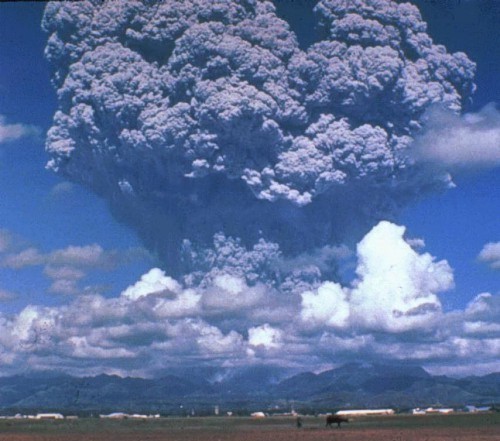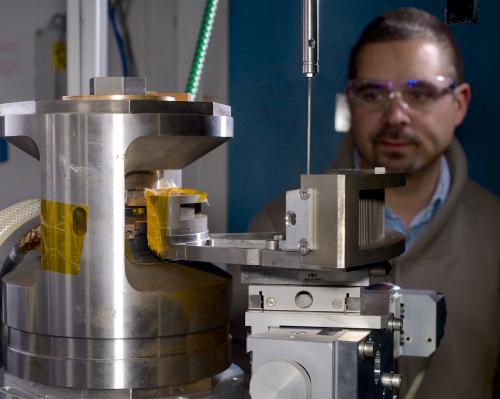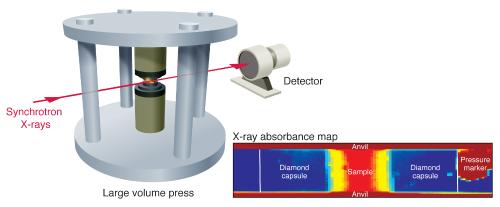- Home
- News
- General News
- Supervolcano triggers...
Supervolcano triggers recreated in X-ray laboratory
05-01-2014
Scientists have reproduced the conditions inside the magma chamber of a supervolcano to understand what it takes to trigger its explosion. These rare events represent the biggest natural catastrophes on Earth except for the impact of giant meteorites. Using synchrotron X-rays, the scientists established that supervolcano eruptions may occur spontaneously, driven only by magma pressure without the need for an external trigger. The results are published in Nature Geosciences.
A well-known supervolcano eruption occurred 600,000 years ago in Wyoming in the United States, creating a huge crater called a caldera, in the centre of what today is Yellowstone National Park. When the volcano exploded, it ejected more than 1000 cubic kilometres of ash and lava into the atmosphere, 100 times more than Mt Pinatubo in the Philippines did in 1991. Big volcanic eruptions have a major impact on the global climate. The Mt Pinatubo eruption decreased the global temperature by 0.4 degrees C for a few months. The predictions for a super volcano are a fall in temperatures by 10 degrees C for 10 years.

Imagine this one hundred times bigger. The eruption of Mt Pinatubo in the Philippines in 1991 was the second largest eruption on Earth in the last century.
According to a report published in 2005 by the Geological Society of London "Even science fiction cannot produce a credible mechanism for averting a super-eruption. We can, however, work to better understand the mechanisms involved in super-eruptions, with the goal of being able to predict them ahead of time and provide a warning for society. Preparedness is the key to mitigation of the disastrous effects of a super-eruption."
The mechanisms that trigger supervolcano eruptions have remained elusive to date. The main reason is that the processes inside a supervolcano are different from those in conventional volcanoes like Mt. Pinatubo which are better understood. A supervolcano possesses a much larger magma chamber and it is always located in an area where the heat flow from the interior of the Earth to the surface is very high. As a consequence, the magma chamber is very large and hot but also plastic: its shape changes as a function of the pressure when it gradually fills with hot magma. This plasticity allows the pressure to dissipate more efficiently than in a normal volcano whose magma chamber is more rigid. Supervolcanoes therefore do not erupt very often.

Jean-Philippe Perrillat, one of the scientists, surveys the experimental set-up on beamline ID27. The Paris-Edinburgh press is on the left. The magma rock sample is compressed in its centre to pressures of up to 36000 atmospheres, and then heated by a resistor to up to 1700 degrees Celsius. The slits on the right filter the X-ray beam reaching the detector. Credit ESRF/Blascha Faust
So what changes in the lead up to an eruption? Wim Malfait explains: "The driving force is an additional pressure which is caused by the different densities of solid rock and liquid magma. It is comparable to a football filled with air under water, which is forced upwards by the denser water around it." Whether this additional pressure alone could eventually become sufficiently high to crack the Earth’s crust, leading to a violent eruption, or whether an external energy source like an Earthquake is required has only now been answered.
Whilst it is virtually impossible to drill a hole into the magma chamber of a supervolcano given the depth at which these chambers are buried, these extreme conditions can be simulated in the laboratory. "The synchrotron X-rays at the ESRF can then be used to probe the state – liquid or solid – and the change in density when magma crystallises into rock", says Mohamed Mezouar, scientist at the ESRF and member of the team. Jean-Philippe Perrillat from CNRS adds, "Temperatures of up to 1700 degrees and pressures of up to 36,000 atmospheres can be reached inside the so-called Paris-Edinburgh press, where speck-sized rock samples are placed between the tips of two tungsten carbide anvils and then heated with a resistive furnace. This special set-up was used to accurately determine the density of the liquid magma over a wide range of pressures and temperatures."

The X-ray beam penetrates the sample inside the press and its interaction with the magma rock is recorded in an X-ray detector behind the press. The insert shows a typical absorbance map recorded by the detector from which the density of the sample is derived. Credit ESRF/Nigel Hawtin
Magma often includes water, which as vapour adds additional pressure. The scientists also determined magma densities as a function of water content.
The results of their measurements showed that the pressure resulting from the differences in density between solid and liquid magma rock is sufficient in itself to crack more than ten kilometres of the Earth’s crust above the magma chamber. Carmen Sanchez-Valle concludes "Our research has shown that the pressure is actually large enough for the Earth’s crust to break. The magma penetrating into the cracks will eventually reach the Earth’s surface, even in the absence of water or carbon dioxide bubbles in the magma. As it rises to the surface, the magma will expand violently, which is the well known origin of a volcanic explosion."
The team was led by Wim Malfait and Carmen Sanchez-Valle of ETH Zurich (Switzerland) and comprised scientists from the Paul Scherrer Institute in Villigen (Switzerland), Okayama University (Japan), the Laboratory of Geology of CNRS, Université Lyon 1 and ENS Lyon (France) and the European Synchrotron (ESRF) in Grenoble (France).
References
Malfait WJ, Seifert R, Petitgirard S, Perrillat JP, Mezouar M, Ota T, Nakamura E, Lerch P, Sanchez-Valle C: Melt buoyancy in large silicic magma chambers as viable trigger of supervolcano eruptions. Nature Geoscience 5 January 2014.
http://dx.doi.org/10.1038/ngeo2042
Top image: Artist's impression of the magma chamber of a supervolcano with partially molten magma at the top. Credit ESRF/Nigel Hawtin



